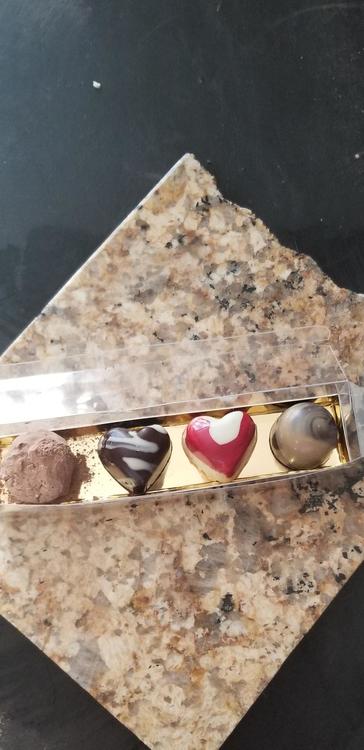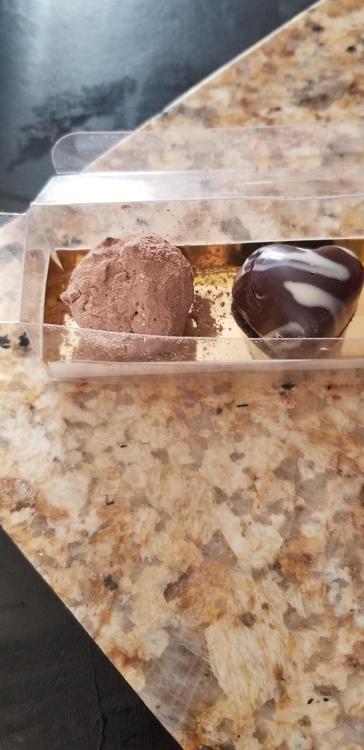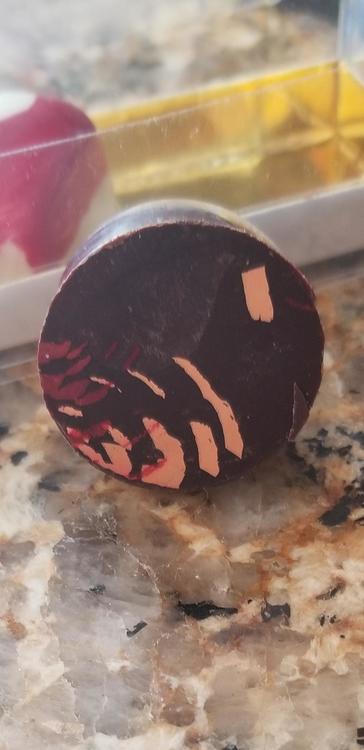-
Posts
119 -
Joined
-
Last visited
Recent Profile Visitors
The recent visitors block is disabled and is not being shown to other users.
-
There are so many great things to fill choux pastry with!! Depending on what type of filling you want to use will often dictate which style of eclairs you will want to dry. Firm fillings such as frangipane or whipped ganache, you can slice in two and then fill the bottom and dip the top in chocolate, caramel, etc. Should not have to scoop anything out since a well-made choux pastry is hollow with only the webbing left. Soft fillings (my usual go-to) such as pastry creams, curds, etc usually require the choux pastry being left whole with vents for them to cool. Most times for me, that is a toothpick hole on both ends or 3 underneath. If I make a pastry cream, I make it a mousseline with whipped cream. Makes it easier to pipe and cuts down on the sweetness, since to me, eclairs are not supposed to be overly sweet. When piping, you can either pipe from one end, or if it is longer, pipe from both ends so it does not burst from piping too much on one end trying to get it to the other side. My favorite of all choux pastry is the Paris Brest though. Incorporates the pastry cream and hazelnut and/or almond frangipane for the filling. So good, and to me, elegant and decadent!! Hope that helps!!
-
.thumb.jpg.1f815dea628f9536f43e2861f4a6f3cc.jpg)
Absurdly, stupidly basic pastry & baking questions
Merry Berry replied to a topic in Pastry & Baking
@ElsieD What type of leaf gelatin did the original call for? Silver, Gold, etc? If one of the lower bloom strengths like Silver, then the half Tbsp would be way too much I would think. But, I think PG is on the right track too. Blooming in water is preferred most of the time since it is neutral pH and there is nothing to interfere with it such as the fats in the heavy cream, acidity of the heavy cream, etc. -
That is not an overly large batch. Couple of places I worked, we utilized Tilt Kettles. But, unless you need 24 gallons per week, I cannot imagine it would be worth you buying a Bravo or Tilt Kettle. When I have to make large batches like you mentioned, I use some of my larger stockpots (start the milk, sugar and vanilla bean) and a large metal mixing bowl for the yolks, cornstarch, and sugar. A couple of times, I have had to do it in 2 batches since it was too much for one go, but pastry cream is pretty quick so not a big deal in the long run.
-
Merry Berry changed their profile photo
-
Dang PG, why couldn't you live closer!! I used to love the week of sugar art when I used to teach culinary school!! It was the most frustrating fun (outside of chocolate of course). I have a lot of notes and recipes, but they are at my shoppe so I can look over them tomorrow, and post them. I definitely say use isomalt, but that price versus sugar for a 12 hour sculpture might be prohibitive. Flame is usually best since dipping in molten sugar can cause stray strings and angel hair of sugar. Flame will make for cleaner edges too. Have you thought about a dead dough sculpture instead? I used to have a lot of fun with that medium too, and would actually hold up a bit longer in high humidity conditions. Sugarwork and rain/humidity are awful bedfellows as you probably well know.
-
I love bonbon inclusions in ice cream myself. Is that a possibility for you?
-
Sure, you should be able to use a normal Italian Meringue for that type of use. Any meringue would probably work just fine, but I do love the silkiness of Italian meringue. The recipe I use is: 185g Sugar, granulated 30g Corn Syrup or Glucose 50g Water 115g Egg whites
-
Are you using it to make the "collar" on the religieuse? If so, typically it is made with a buttercream and would be plenty stiff for your needs. As you mentioned, the picture you posted is exactly what I am looking for when I make my Italian meringue. Silky and smooth, but I would not call it stiff. If I needed it to be stiff, I would definitely turn it into a buttercream. I have never tried the higher syrup temperature tip the others mentioned, but cannot hurt to try. I only take mine to 240-242°F. As T said, I start whipping the egg whites when the syrup reaches 220°F. If you are adamant about a stiff meringue, why not utilize a French meringue?
-
Did you feel the creme fraiche flavor came through on the ganache? I am going to make up a batch of creme fraiche today to try it out in a ganache. I love that idea!! But was curious if you got much of the tangy flavor from it. I have done a goat cheese ganache before that had a really nice smooth and tangy flavor.
-
Did a chocolate gift box for a client for New Years. Truffle is Honey Clove (my fave of this run). Black heart is Salted Caramel. White heart is Raspberry Ganache. Dome is Bailey's Coffee Ganache. Was definitely a little rusty, but glad to play with chocolate again. Here's to hoping I get to do more in 2020!!
-
The neutral glaze I use is two parts water to 1 part sugar, and 1/5th pectin. Boil for a couple of minutes and store until needed or use right away after cooling some. Have you tried it without the citric acid? Acids will start to set the pectin before you have a chance to use it. Have you thought about utilizing a simple gelatine-type neutral glaze instead of pectin based? Gelatine glazes usually give you a little bit more time to spread and smooth over the entremet before it sets up completely.
-
If you feel like you might be incorporating too much air into your batter, you might be onto something. 20 qt mixers are so much more powerful than the 6 qts and require much less time to mix everything together. For a lot of my cake and cookies on the 20 qt, I am mixing on speed 1 only, after the creaming process is complete (sometimes speed 2 for the egg addition, and then speed 1 for the rest). I do not even bother softening the butter before creaming it in large mixers since they are powerful enough to soften it in a about a minute. Do you let the dough rest and hydrate in the cooler for a few hours after mixing? Do you scoop the dough and then let those rest in the cooler or freezer until ready to bake? What type of cookie are you making?
-
Yes, I should have clarified using the glycerin type. It is the only one I use and forgot the others have alcohol.
-
I know for cakes, mixing luster dusts with lemon extract is an alternative for people who do not wish to mix it with vodka or everclear. Like you said, the alcohol evaporates so it is annoying when people insist on zero alcohol touching something. When I have used dusts in the past for chocolates, I use a paint brush or blush applicator to lightly dust the molds and then flip over to knock out any excess. The molds, even when dry, hold on to plenty of the dust and really, it just takes a light touch of it on the brush to apply. I would trust what keychris said as well.
-
I too have been making fudge the past couple of months for a few clients and have a few thoughts on it. Here in the South, it seems more commonly, people grew up with the crystallized type instead of the smooth and creamy fudge. When I first started making the chocolate version, I made it by taking it to 236°F, letting it cool for about 20 minutes and then agitating it in a mixer for a few minutes until smooth and then let it set up the rest of the way. It tasted and felt weird to me since growing up, I had only had the crystallized type. It was not bad, just took some getting used to (kept reminding me of Tootsie Rolls). Since then, I have gone to the crystallized version since it seems more in line with what most customers expect here. Secondly, I definitely do not use 234°F as the max temperature since so many things can go wrong with it. I shoot for 236-238°F since my thermometer could maybe be off a degree, or it my pan might not be uniform in temperature (I place the probe in the middle of the pot off the bottom, but my stove definitely heats higher on the upper left side than the lower right. If it is rainy, damp, and/or humid, I usually take it up to 240°F since the extra moisture can be a pain. 234°F is the very bottom end for fudge or it is at least where I live. You have a range of 234-241°F to work with, so I do not trust the lower end of the range in case something is off. My first batch of fudge, I took to 234°F and I had the same problem you are describing. One other time, something was off and it set up too loose to cut up so I set it aside wrapped in parchment paper until I had a chance to reheat it to the right temp. I put it in a cool, dark location and had no time to fool with it for about 2 weeks. In that time, it kept crystallizing and when I went to redo it, it was actually a perfect consistency by that point.
-
Of course he did. What do you know about chocolate and the EZtemper 🙄 Don't ya just love it when people ask for help, but swear it just CANNOT be them that is causing the problem?







